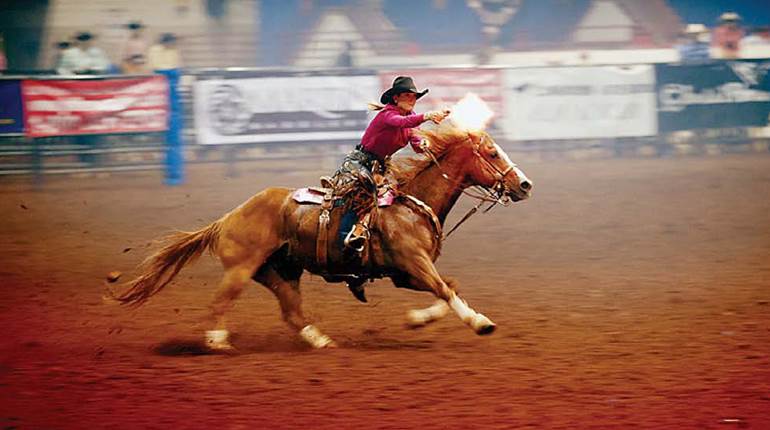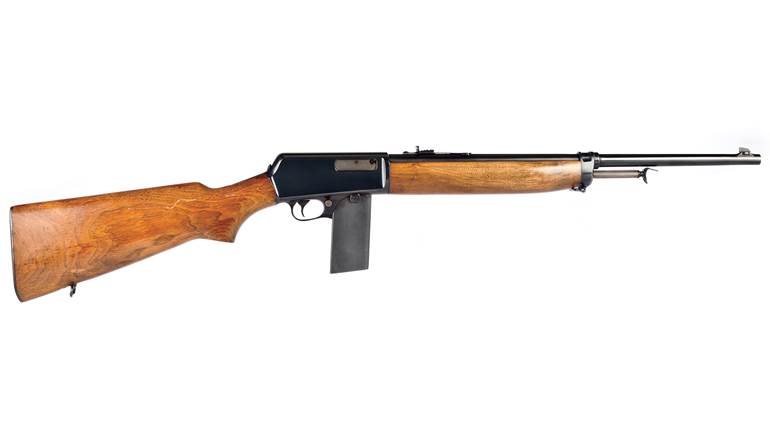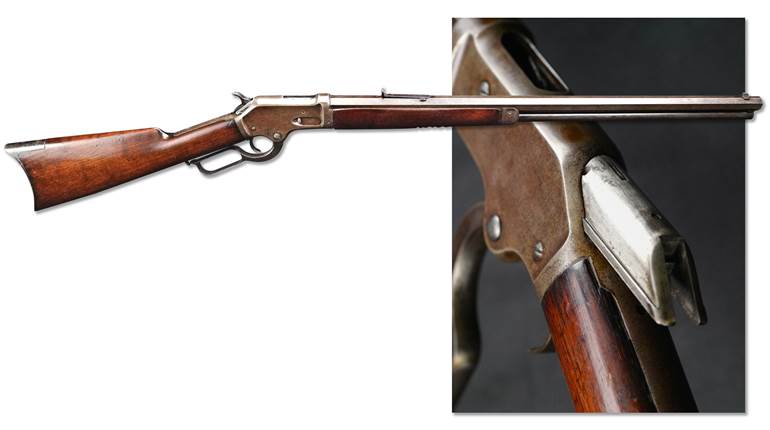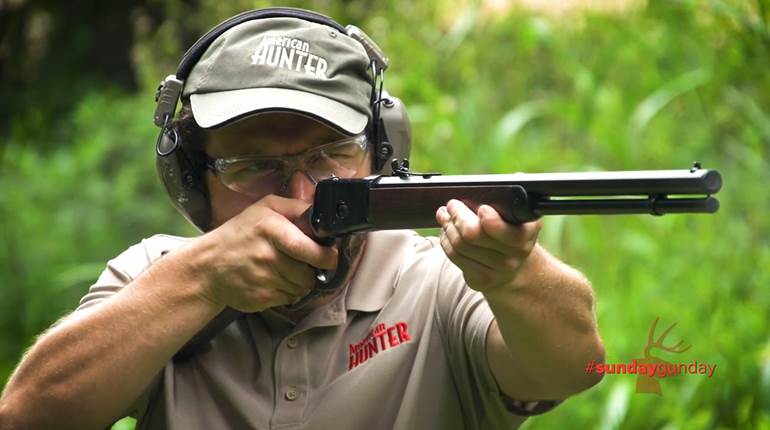
Griffin & Howe’s early gunsmithing workshop, located on East 39th Street in New York City, is seen in this photo taken around 1930 (above). A gunsmith meticulously works on a Griffin & Howe shotgun in 2007 (inset), demonstrating the individual attention to detail that still prevails at G&H to this day.
If it hadn’t been for ex-president and NRA Life member Theodore Roosevelt’s Smithsonian-sponsored African safari of 1909-1910, the firm of Griffin & Howe might never have come to fruition. That’s because a talented young New York cabinetmaker named Seymour Robert Griffin working out of Hotel Bretton Hall—an apartment/hotel in Manhattan—might never have been inspired to create his version of the .30-’03 Sprg.-chambered, sporterized M1903 Springfield rifle that Roosevelt took on his famous expedition to the Dark Continent.
And, a few years later, if it hadn’t been for Col. (then Maj.) Townsend Whelen, one of the most influential gunwriters of the day (and a longtime contributor to The American Rifleman and its predecessor, Arms & The Man) discovering Griffin’s talents and teaming him up with a skilled Pennsylvania metalworker and gunmaker named James Virgil Howe, the entity known as Griffin & Howe would never have been founded and, consequently, would not be celebrating its 100th anniversary this year.

It all began with the 1910 publication of Roosevelt’s book, African Game Trails, which vividly recounted the former president’s two-year adventures in what are now parts of Kenya and Uganda, including descriptions of the guns he used. While Roosevelt’s Winchester Model 1895 and .500/450 Holland & Holland Royal double rifle garnered most of the publicity, Roosevelt also chronicled his sporterized version of the U.S. Army’s Model 1903, Serial No. 6000, that Springfield Armory had customized for the president in 1903, making it the first sporterized version of the military’s recently adopted .30-’03 bolt-action. Subsequently, it became one of Roosevelt’s favorite rifles for hunting cougar and bear, and he, understandably, took it to Africa for thin-skinned game such as warthogs and wildebeests. He also ordered a duplicate of the sporterized Springfield for his son Kermit to take on this same expedition. These guns were to become the predecessors of numerous surplus Springfields that flooded the market following the Armistice of World War I and inspired gunsmiths such as Sedgley, Newton and Wundhammer to create their own custom versions of the Army’s bolt-action.
Like Roosevelt, Griffin was also a gun enthusiast and an admirer of the M1903 Springfield. And, as a result, he had eagerly read TR’s book, taking special note of Roosevelt’s Springfield, “stocked and sighted to suit myself” as TR had written, and which featured a 24"-barrel, a cheekpiece and a shotgun butt. But the checkered half-stock itself, which sported a barrel band, was of a rather ungraceful, elongated shape. Seymour Griffin felt he could do better.
Thus, like numerous other gun tinkerers of the day, he acquired one of the relatively inexpensive surplus M1903 Springfields, but being a skilled woodworker, he obtained a premium blank of finely figured Circassian walnut from Von Lengerke & Detmold, an upscale New York sporting goods dealer (that, ironically, would become part of the future firm of Griffin & Howe a few decades later). Griffin then carved a gracefully contoured new stock for his rifle. The results were so distinctively pleasing that Griffin barely had time to bask in the ownership of his creation before a friend offered to buy the rifle for a price the fledgling gunmaker couldn’t turn down.

Undeterred, Griffin promptly purchased another Springfield, created another finely carved stock and was subsequently offered another substantial sum of money for the rifle. Soon, Griffin found himself supplementing his cabinet-making income by creating stylish bolt-action sporters using surplus Springfield and Rock Island Arsenal rifles for a small but affluent coterie of appreciative shooters. As his gunsmithing skills progressed, he developed and perfected a distinctive style: His handsomely oiled and hand-rubbed stocks were noted for their finely crafted inletting, ultra-fine hand-checkering, schnabel fore-ends and Griffin’s trademark—a downward-angled slope cut into the stock parallel to the bolt ejection port.
With a rifleman’s sense of form and balance coupled with shaping and checkering proficiency, Griffin continued using Circassian walnut, eventually having many of his guns re-barreled (although unmarked) by Harry M. Pope, one of the finest gunsmiths of his day. In addition, Griffin had a number of his rifles engraved, primarily on the floorplates and trigger guards, often utilizing the skilled talents of R.J. Kornbrath. Interestingly, Griffin did not mark his work until 1922, when he began using a small “S.R. Griffin New York” banner.
Still, it didn’t take long for acclaimed gunwriter Townsend Whelen to start praising Griffin’s talents to a national audience of readers, which, in turn, brought Griffin—who did not advertise his gunmaking services—to the attention of more shooters. Finally, Whelen, who also happened to be the commanding officer at Frankford Arsenal and director of research and development at Springfield Armory, hit upon the idea of forming a company that would combine Griffin’s skills with those of talented gunsmith and metalworker James Virgil Howe, who was in charge of the armory’s Small Arms Experimental Dept. Both men were intrigued by the idea, and with the financial assistance of investors James M. Holsworth and James L. Gerry, the firm of Griffin & Howe (with Holsworth and Gerry serving as treasurer and secretary, respectively, and Griffin as president) opened for business on June 1, 1923, working out of a loft at 234 East 39th St. in New York City. Unfortunately, it was to be a short-lived union between the two skilled gunsmiths, for, in September of that year, Howe abruptly quit the company and went to work for a competitor—the Hoffman Arms Co. of Cleveland, Ohio.
“He only stayed long enough to get his name on the door,” noted Paul E. Chapman, Griffin & Howe’s current vice president and director of gunsmithing.

Undaunted, Seymour Griffin continued to maintain the Griffin & Howe name, even though, for the next seven years, he was a one-man operation. But he gradually assembled a small-but-talented group of American and European gunmakers and engravers that soon established Griffin & Howe’s reputation for building some of the world’s finest custom bolt-action sporting rifles, primarily based upon M1903 Springfield and Mauser 98 actions. Superbly grained walnut stocks, fine line checkering, folding leaf express sights, intricate engraving, initials and coats of arms inlaid with precious metals and a trapdoor in the buttplate for the carrying of extra rounds were the norm. Griffin & Howe’s superbly accurate barrels were now often obtained from the equally famous Niedner Rifle Corp., with more than 14 different chamberings available, although customers could order practically any cartridge they desired.
Adding to the firm’s distinction, in addition to also “Outfitting African Expeditions,” as listed in its 1925 catalog, in 1927, Griffin & Howe developed a detachable scope side mount, which the company patented. By simply flipping up two levers, the scope could be lifted off the rifle, allowing the use of open sights and easing transport. Repositioning the scope on the rifle and rotating the levers down locked the scope back in place, with no loss of zero. Later, during World War II, this scope mount was adapted for M1 sniper rifles; today, this same G&H detachable scope mount is still in the line. In addition, for a brief period, Griffin & Howe had its own brand of ammunition. This included a number of proprietary cartridges such as the .350 G&H Magnum (a necked-down .375 H&H Mag.), the .400 Whelen and, of course, the .35 Whelen—which Howe originally developed and which is still available today, thanks to companies such as Barnes, Remington, Federal, Hornady, Nosler, Buffalo Bore and DoubleTap.
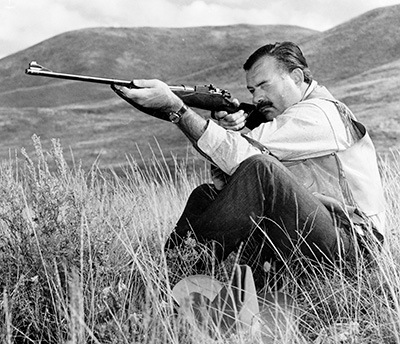
Although it had emerged during the affluent Roaring Twenties, the subsequent Great Depression was not conducive to custom riflemakers like Griffin & Howe. In fact, according to the late Michael Petrov, author of Custom Gunmakers Of The 20th Century, it is estimated that fewer than 2,000 rifles were produced by Griffin & Howe between 1923 and the outbreak of World War II, which, of course, halted its civilian gunmaking endeavors. In an effort to supplement the company’s income during those prewar years, in 1930, Seymour Griffin began to import and market fine British and European shotguns, a practice the current firm of Griffin & Howe still follows today.
Nonetheless, Seymour Griffin must have been greatly relieved when, also in 1930, he was approached by James S. Cobb, president of the well-known luxury sporting goods outfitter Abercrombie & Fitch, with an offer to bring G&H into the folds of the more secure A&F stronghold. It turned out to be a perfect union, enabling Griffin & Howe to continue building and customizing rifles for a distinguished clientele that was growing to include such prominent names as Bing Crosby, Clark Gable, Jack O’Connor and Robert Ruark, to name but a few. More recent customers include the late Bill Ruger and past NRA Board Member Tom Selleck. Interestingly, one of Selleck’s Griffin & Howe rifles—an exquisitely engraved Savage Model 99 in .300 Savage that was manufactured in 1927—was sold by Rock Island Auction on Dec. 10, 2022, for $41,125.

Another notable G&H customer was famed novelist and sportsman Ernest Hemingway, who became a customer of Griffin & Howe the same year it merged with Abercrombie & Fitch. Like Griffin, Hemingway was an admirer of Theodore Roosevelt and his book, African Game Trails. Inasmuch as Hemingway was planning his first safari to Africa, it was inevitable that he would connect with the famed New York gunmaker to create what he considered to be the ultimate hunting rifle. To accomplish this, as recounted in the excellent book Hemingway’s Guns by Silvio Calabi, Steve Helsley and Roger Sanger, Hemingway was assisted by none other than Townsend Whelen. He personally picked out a new, unstocked National Match Grade Springfield M1903 action for the author—which Hemingway ordered from the Director of Civilian Marksmanship after first joining the NRA to qualify for the $30 price of the unfinished action. As noted by the authors, having Whelen involved in selecting “a civilian customer’s rifle was not unlike having Henry Ford pick out one’s car.”
Hemingway even went so far as to send Griffin & Howe his physical measurements, including a photograph of himself, to create a rifle of perfect proportions—for him, at least. The resultant G&H .30-’06 Springfield sporter, bearing G&H Serial No. 956 (the company always re-numbered its rifles with proprietary serial numbers) ended up costing Hemingway $256.50—about five times the price of a standard Winchester Model 54 at the time—and came with G&H’s detachable side-mounted scope, which Hemingway soon discarded. He preferred to use the rifle’s open sights and subsequently harvested everything from mule deer to Cape buffalo using them—the latter of which required 12 shots to finally stop its charge just inches away from the future Nobel-prize winner. Unfortunately, while many of Hemingway’s guns have survived in one form or another, his cherished Griffin & Howe ’06 was stolen a few years after his death in 1961. As related to me by Guy Bignell, former president of Griffin & Howe:
“By the late 1970s, [the rifle] had found its way to Ernest’s son Patrick Hemingway’s home in Montana. Sadly, it was stolen from here, it is believed by a gang of American/Irish Pro-IRA supporters, who shipped it to Ireland where it probably resides today without anyone knowing its provenance, or, if captured, destroyed by the British army or constabulary.”

One of Hemingway’s closest friends, a frequent hunting companion and a fellow admirer of Griffin & Howe rifles was multiple Academy Award-winning actor Gary Cooper who—unrealized by many of his fans even today—was an avid gun collector and a hunter credited with more than 60 big-game kills on numerous safaris in Africa. Cooper owned at least two Griffin & Howe rifles custom-built for him, both with silver ovals inletted into the stocks engraved with his “GC” initials. One of these rifles was a .30-’06 Sprg., the other was a Zeiss-scoped .22 Hornet (G&H Serial No. 1075), built for him prior to 1935. As recounted by Jeffrey Meyers in his book, Gary Cooper: American Hero, “Hemingway coveted Cooper’s favorite rifle, a .22 Hornet with a German telescopic sight, and asked: ‘Coop, if you die before I do, are you going to will me that Hornet?’ Cooper promised to do so, but then said: ‘Hell, I might just decide to give it to you now so I can watch you enjoy it.’” Given the late actor’s affinity for the guns in his collection, it is highly doubtful that this ever happened, but nonetheless, on Sept. 11, 2021, that particular rifle was sold by Rock Island Auction for $34,500.
After Seymour Griffin retired in 1958, Griffin & Howe continued to build and market rifles under the Abercrombie & Fitch banner until 1977, when that once-famous adventurer’s outfitter went out of business, a victim of changing times and a changing customer base. While the Abercrombie & Fitch brand continued to limp along for another 10 years under Oshman’s Sporting Goods ownership, Griffin & Howe itself was purchased by one of its former gunsmiths, Bill Ward, along with a prior A&F employee, John Realmuto. Twelve years later, after multiple relocations and over-expansion, Griffin and Howe was acquired by a wealthy investor and his partner, businessman-sportsman Joe Prather, who eventually re-located the company’s headquarters to Bernardsville, N.J.—out of what had become the gun-unfriendly city of New York.

The company then opened a second location in Greenwich, Conn., and, in 2003, established a new showroom and outfitting location in Andover, N.J., alongside its shooting school. Prather retired as president and became chairman emeritus in March 2007, and he was succeeded by Guy A. Bignell, who had been associated with the company since 1993. Bignell remained with Griffin & Howe as its fine sporting arms specialist after stepping down as CEO on June 1, 2017, handing the position of G&H president and CEO to another longtime employee, Steve Polanish—who has now become Griffin & Howe’s sixth president in its 100-year history.
In a way, the future of Griffin & Howe actually began when Polanish joined the company in August 1998, right after graduating college, and began his tenure by cutting down trees to make room for the company’s first sporting clays course while also booking various shooting events. His responsibilities grew over the years, and today, Polanish oversees a rifle- and handgun-shooting and safety academy, bow-hunting classes and numerous charity fundraisers and shooting-related events—all headquartered at Hudson Farm in Andover, N.J. Although all are activities that Seymour Griffin probably never imagined, some things remain unchanged.
Quoting from Griffin & Howe’s website (griffinhowe.com), “Griffin & Howe still builds a limited number of America’s finest custom rifles the way we have for the past century. We incorporate the classic shape and proportion of the European walnut stock with a cheek piece and a hand-rubbed oil finish, the Griffin & Howe quarter rib with standing bar and folding leaves, the Lyman 48 sight and all other Griffin & Howe features that have been the hallmark of the company from the very beginning.
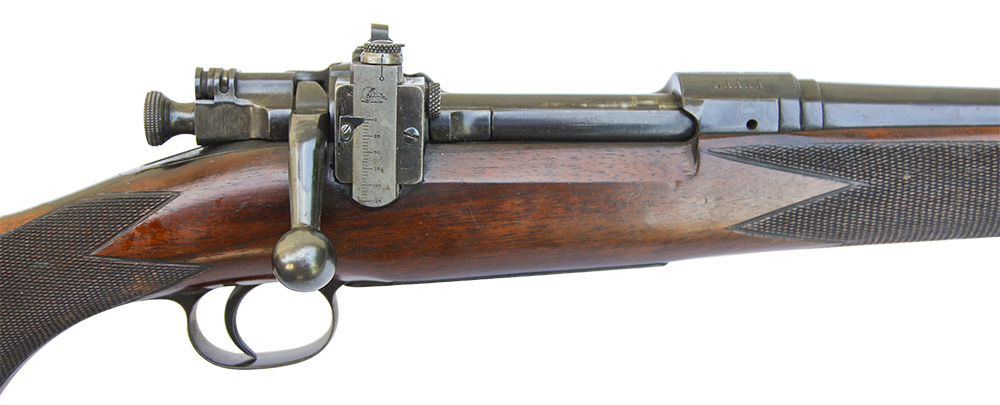
“We also offer an extensive line of sporting shotguns, rifles and double rifles, built to our specifications by fine European makers, as well as being the official agents and U.S. representatives for James Purdey & Sons, Boss & Co., Lebeau-Courally, David McKay Brown, Verney-Carron, Fabbri, Blaser, Krieghoff, B. Rizzini, Beretta, Zoli and Perazzi, to name a few of many others.”
As Griffin & Howe enters its second century serving a discerning clientele, Polanish has a vision for the future that continues to draw from its past.
“We are going back to what and who we were when owned by A&F, an outfitting company,” Polanish said. “We are a destination for clients to be educated, trained, outfitted and sent on trips. We will handle the firearms, optics and clothing. Putting you with the right outfitter, then making sure your work has gone to the right taxidermist. We are also affiliated with the New Jersey Division of Fish & Wildlife (by allowing) them to host their hunter education courses on the property to have clients and public get their firearm and archery certification. We are also expanding our gunsmithing and rifle-building services, in addition to teaching and educating students at the American Custom Gunmakers Guild gunsmithing school being held at our facility.”
Additionally, to celebrate its 100th anniversary in the finest G&H tradition, a limited series of commemorative hunting rifles is being produced this year, which include the Griffin & Howe All-American, incorporating an American Rifle Co. Mausingfield action that combines the best features of the Mauser and Springfield actions, a Proof Research carbon-fiber barrel, a two-stage Huber Concepts trigger and choice of chambering. A lightweight Highlander is also being offered in a range of cartridges, with a McMillan composite stock, carbon (DLC) coating on all gunmetal, single-stage TriggerTech trigger and a stated 1/2-m.o.a. accuracy with factory ammunition. In addition, a limited number of rifles chambered in .35 Whelen will be made this year, along with similar limited-edition tribute rifles to Theodore Roosevelt and Ernest Hemingway, both in .30-’06. Other 100th-anniversary limited-editions are also planned.
Indeed, even though there are, once again, a finite number of custom rifle craftsmen in the country, only Griffin & Howe remains as the sole survivor of America’s golden age of early 20th century custom rifle pioneers.












